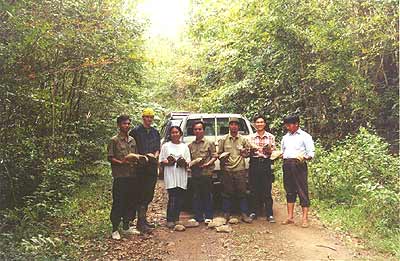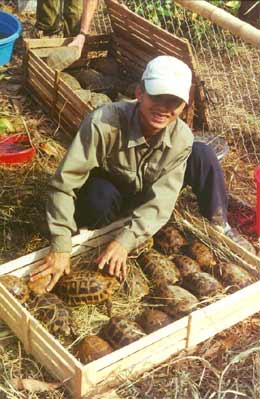
A Second Chance for Turtles
(TCEP Press Release, November 30, 2000)


Rangers help the TCEP translocation team
release turtles at Cat Tien National Park. |
 |
On November 25, a task force involving wildlife protection authorities from three provinces, the city of Hanoi, Fauna and Flora International (FFI), and the World-wide Fund for Nature (WWF) at Cat Tien National Park carried out the country’s first large-scale translocation of turtles back to their native habitat in the south of Vietnam. The release involved 366 Indotestudo elongata (the elongated tortoise), which were seized from illegal wildlife traders in the north of Vietnam as they were being smuggled to China. They represented individuals from six separate shipments. Ninh Binh and Thanh Hoa provincial rangers had rescued half of the tortoises as they traveled north in trucks and buses along National Highway 1. Another shipment was discovered in August by the Hanoi Forest Protection Branch on a Vietnam Airlines flight from Ho Chi Minh City. Cat Tien National Park (Dong Nai Province) was selected as the release site based on the suitability of habitat, prior records of the species’ occurrence at the park, and the high level of effectiveness demonstrated by Cat Tien rangers in protecting the park.
 |

Nguyen The Cuong prepares turtles for shipment to Cat Tien. The tortoises were soaked in water before being carefully placed in straw-lined crates. |
For the return trip south, the turtles were packed in straw within specially designed crates and loaded aboard a hired truck. Staff of the Cuc Phuong-based Turtle Conservation and Ecology Project (TCEP), Soc Son director Pham Nhu Bich, and Nguyen Van Nhung, a veterinarian from the Hanoi Forest Protection Branch, accompanied the shipment to Cat Tien National Park. The tortoises were then unpacked and held in secure enclosures prepared by the park, before being released in small groups at secret locations within the park.
“Some of these tortoises, which are probably 40–60 years old, were on their way to China less than a month ago,” says Douglas Hendrie of FFI, who manages the TCEP. “For the tortoises, this is a second chance to complete their natural life where they belong.”
Hendrie said that as recently as four years ago there were reports of up to 18 tons of turtles crossing the border into China each day. “Turtles are long-lived species,” Hendrie says. “Some species may require a life time to replace themselves.”
Scientists are quick to note that turtles have been around for 200 million years. Their survivorship strategy seems to have worked well in a world without humans. But Hendrie and other turtle conservationists harbor doubts about whether turtles can survive in the modern world without serious intervention. Scientists warn that exploitation of turtles to feed the insatiable demand of Chinese markets is systematically destroying Indochina’s wild turtle populations. Hendrie notes that “ten years ago, much of the trade in turtles was coming from source areas in Vietnam. However, most of what we are seeing today is probably from Cambodia and Laos.” These assertions are supported by evidence from the field suggesting that Vietnam’s turtles are nearly exhausted, with remnant populations of some species holding on in shrinking natural areas that remain under significant hunting and encroachment pressures from outside.
“The best way to ensure that turtles remain a part of Vietnam’s natural heritage into the 21st century is to provide greater protection for turtles which still exist in their natural habitat,” Hendrie says.
“This will require a serious commitment by protected area managers to increase the effectiveness of their enforcement units, and to build a determined and successful enforcement program aimed at both protecting wildlife and wildlife habitat.”
Through cooperation with a growing network of provincial ranger units, the TCEP hopes to encourage other provincial wildlife protection authorities to increase the level of protection for Vietnam’s remaining turtle populations. The Cat Tien release represents an important step in conservation of Vietnam’s turtles. “The turtles released at Cat Tien may not save the world for turtles, but they have been returned to the region where they belong and given another chance,” Hendrie says. “All of us who were involved in this process, especially the Cat Tien rangers, who provided essential ground support once the turtles made it to the park, hope that this release will set an example for others to follow, and bring immediate attention upon the need to do something now to protect Vietnam’s endangered wildlife before it is too late.” 
|